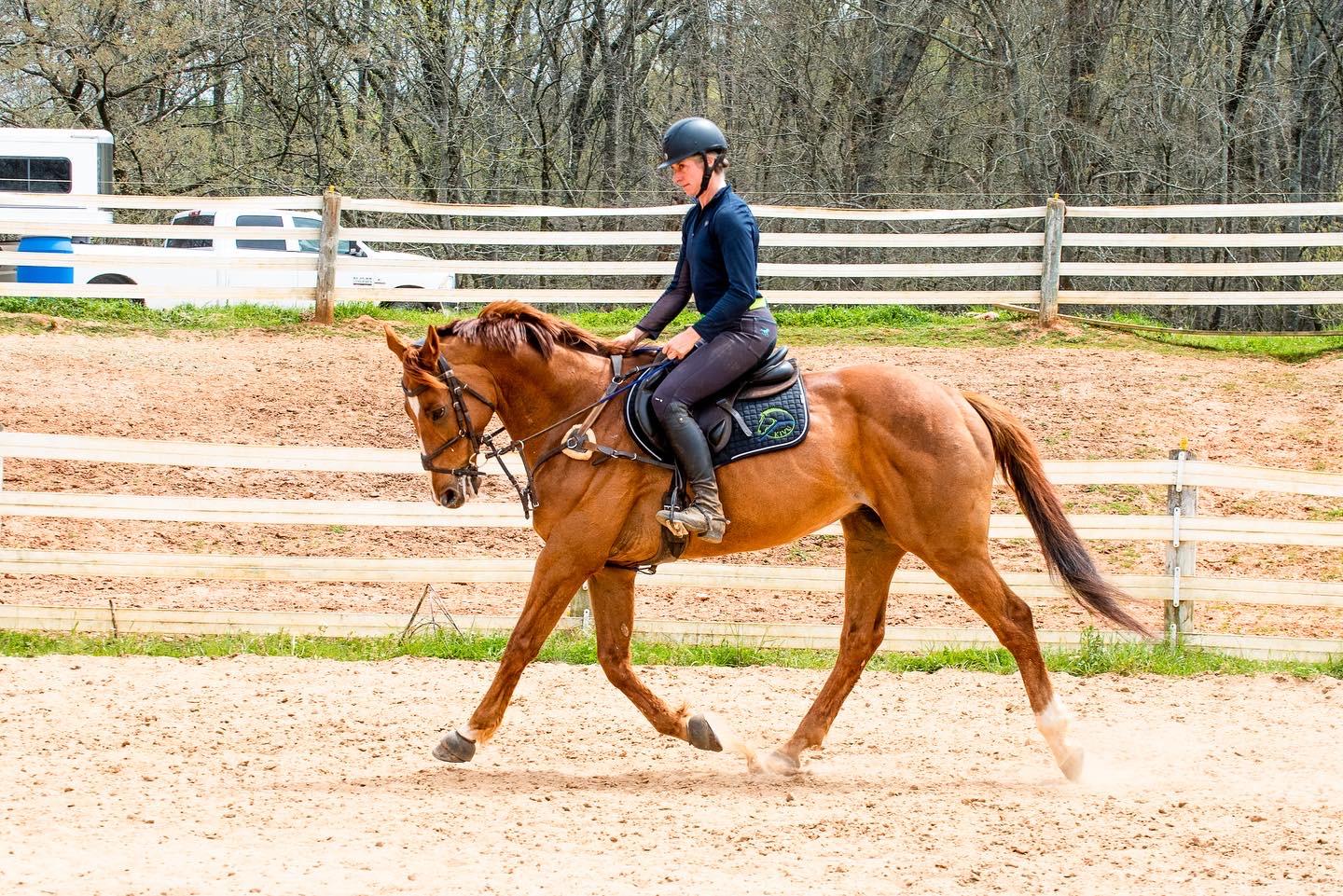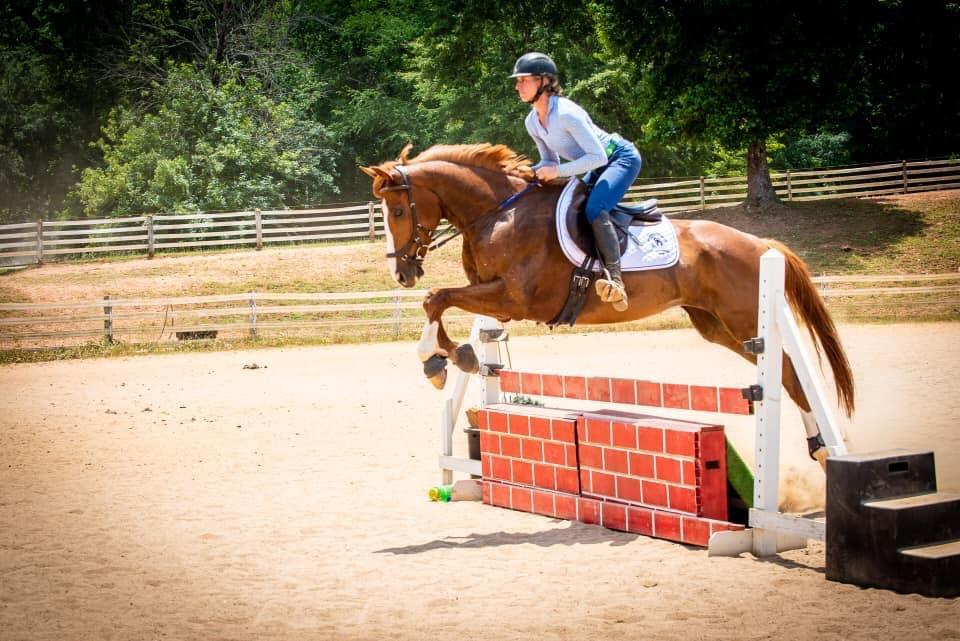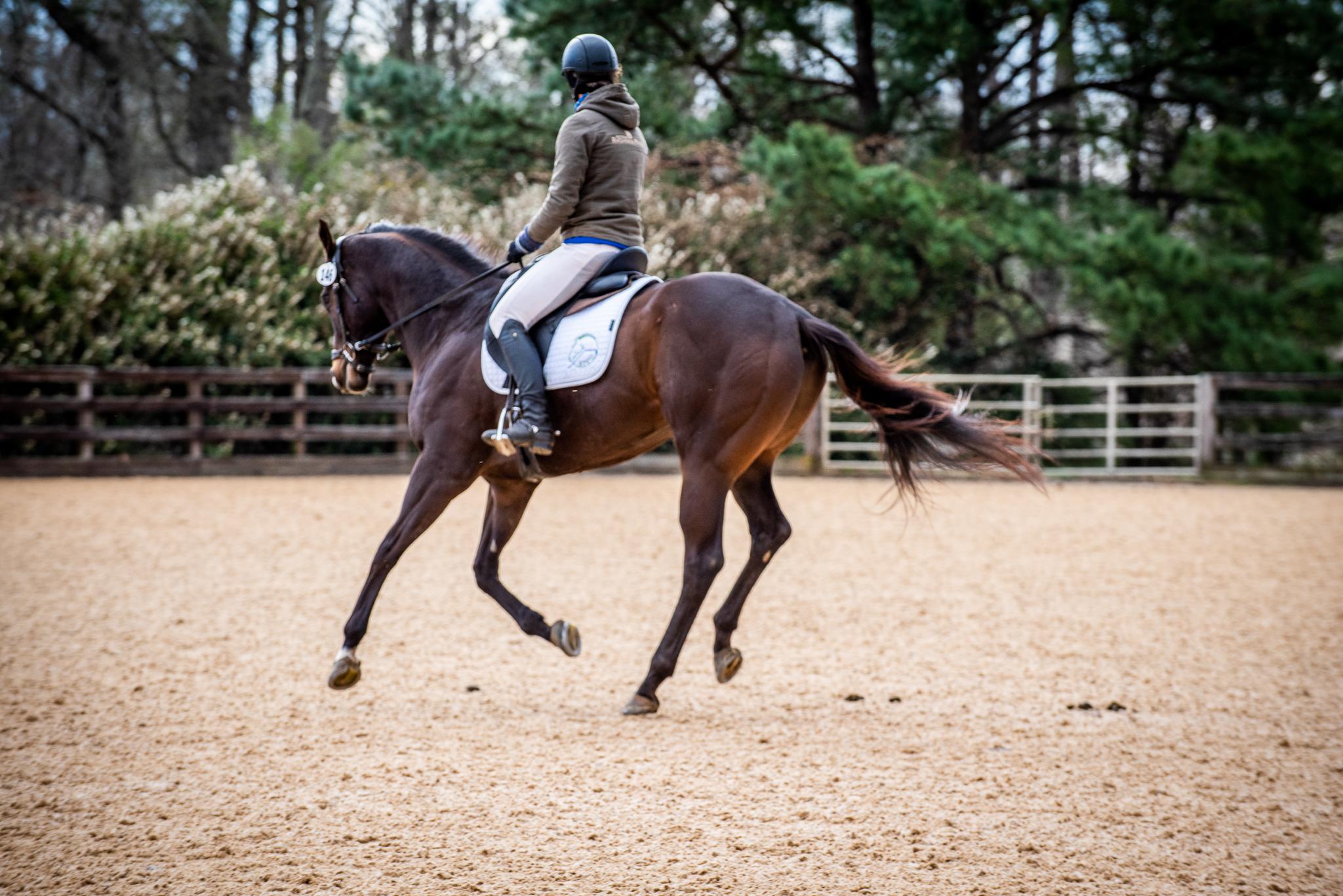
Thoroughbred Logic: Intentional Riding, Part 1
“For most young/green Thoroughbreds… too much leisure and unfocused hacking can be a contributing factor for distraction, and all sorts of ‘bad’ behavior. Yes, knowing how to mosey about is good, but repetitive schooling without intention can get dicey for these horses.”
Welcome to the next installment of Thoroughbred Logic. In this weekly series, Anthropologist and trainer Aubrey Graham, of Kivu Sport Horses, will offer insight and training experience when it comes to working with Thoroughbreds (although much will apply to all breeds). Come along for the ride as she offers her logic on how to ride intentionally in order to keep a horse engaged and progressing.
“Be more interesting” has become one of my favorite training adages. I nabbed this phrase from trainer friend of mine, and now often use it to get riders to re-focus their horses who have found something more intriguing than the direction given by the human they tote around. When I break it down though, being interesting isn’t about just kicking on or making sure they have contact. It is about riding intentionally.
As with many things, I dove into this topic and then quickly realized that there is more here than a single week’s worth of writing. This week focuses on: Keeping arena work relevant and interesting, while the next week’s will add to that with discussions about being flexible/riding the horse you have that day… and the importance of cross training.
Lots of riders get stuck in ruts. Life happens, horses happen, and there are never enough hours in the day. Rides become (or are desired to be) about relaxation and leisure: walk, trot, canter, maybe jump a little bit. Hop off. For a lot of horses, this is just swell. Hell, most of my childhood/teenage years were spent astride a horse chatting with my friends (my trainer probably wanted to murder all of us…and fair enough).
For most young/green Thoroughbreds, however, too much leisure and unfocused hacking can be a contributing factor for distraction, and all sorts of “bad” behavior. Yes, knowing how to mosey about is good, but repetitive schooling without intention can get dicey for these horses for a couple reasons: A) Thoroughbreds (and oh-so-many others) are smart, and particularly prone to get bored and find other distractions that are more interesting (that fly is really annoying… wait, where did my friends go?…) And B) they also get stuck in associated ruts that lead to “naughtiness” when you try to change it.

Louis (Unbridled Bayou) is a growing 4-year old whose easily-distracted level is always high. Short, intention-driven, but fun rides work best to keep him engaged. Photo by the Kivu team.
Negative behavior can manifest in a number of forms:
- Anticipatory: After trot, we walk, then we canter… so when we walk after trot, we jig and do all sorts of silly things to break into the canter.
- Predictable: Doing the minimal necessary to accomplish the movement/getting dull and refusing to stay in front of the leg.
- The straight up no bueno: balking, bucking, rearing, spooking, bolting… you get the point.
Such responses can show up both when one doesn’t change the riding pattern… or when one finally does, and said equine no longer thinks that such work is part of their job description… Yep, riding is hard. Best to keep it interesting and avoid the ruts.

After his halt at Chatt Hills, Mountain got a chance to look around and realize all the glorious distractions. Photo by Amanda Tozzi.
So if riding intentionally is a major contributing factor in keeping horses interested in their jobs, and thereby, behaving and progressing, the question then becomes: How does one do that? What does this whole “being more interesting” thing even mean? Here’s my take:
Key factors in intentional riding are the identification of both what one is “working on” at the same time as one pursues what one is “working towards.” Grammar matters, apparently, even in the horse world. (And yes, in a former life, I spent a few years teaching English as a Foreign Language – I’m glad to finally find an equine use for my love of phrasal verbs. Also yes, I am a nerd.)
 With Seeker, I am still working on settling his rhythm and containing his right shoulder. Progress is slow but steady. Photo by Kelly Robison.
With Seeker, I am still working on settling his rhythm and containing his right shoulder. Progress is slow but steady. Photo by Kelly Robison.
“Working on” indicates addressing the foundational pieces I am trying to train, as well as the bits and bobs that I am troubleshooting. So, for the green Thoroughbreds, this often takes the form of aiming to improve rhythm, straightness, acceptance of the half halt, transitions, while also not leaping sideways when next to new barrel jump, not locking the jaw, or not over-bending to the left, etc.
“Working towards” something means that you have goals and are building skills and abilities to attain them. Such goals tend to be writ a bit larger than the small bits that you are working “on” (and of course, these two concepts are not mutually exclusive). For instance, my “working towards” often includes: getting a training horse ready for their ammy owner, preparing to move up a level in competition, installing the skills for off-property hacking, or preparing a horse for sale.

Crafty (JC Crafty Charger), schooling at home last year, while we were training for his return to Novice. Photo by the Kivu Team.
One can ride both concepts concurrently, but each takes a bit of conscious work. With Mountain (JC Mountain Holiday), for instance, I am constantly working on his shoulders. He tends to lock up at his neck and fake a frame while leaning down and forward into his gates. Whether I am jumping him or flatting him, I work on loosening his shoulders and unlocking his jaw, neck and topline so that he can sit down and push from his hind end.

Here’s Mountain at Poplar, tight and locked through his shoulders but still being a super good kid in the bloody cold, windy warm-up. Photo by Cora Williamson.
To train this and keep him engaged and happy, I pay attention to (and praise) the points where he is good at softening (trotting or cantering to the left), attend to the movements where he struggles (down transitions), and try to avoid drilling at all costs. In those spaces, I can work on his issues by adding skills and asking him to move over, flex through his shoulder and soften through his jaw. He stays attentive, and we chip away at his particular challenges with each ride.
On the other hand, Mountain is working towards his Beginner Novice three-phase debut. He will do a BN Combined Training next week. These physical (often “oh shit, gotta prep for that”) goals help keep my training on track and guide the broader “what am I doing in the arena today?” question. With that in mind, Mountain needs to know how to do all the movements of the BN dressage test. He also needs to be comfortable jumping bending lines and quietly clearing a course of 2’7” verticals and oxers. So we progressively build those flat and fence components into his arena work.

Previously, Mountain had trained up for the goal of completing a Tadpole 3-Phase at Poplar. Here he is making easy work of the tiny jumps. Photo by Cora Williamson.
When intentional riding gets broken down to what you are “working on” and “working towards,” it seems pretty simple. But of course, with all things horse-related, simple is a ruse. That said, there are a few handy ways to help set goals and address issues.
First and foremost, ask your trainer/coach. They should be able to identify areas to work on and exercises that will help to improve your horses’ performance. Then to further spice it up, there is always inspiration in the stadium courses and dressage tests that sit just above your current competition level. Building their elements into regular arena work helps to break up the just-keep-circling monotony.
Rhodie (JC Western Ridge, AKA The Dragon) makes a good example here. Despite Rhodie’s most recent competition being BN (he’s debuting at Novice this weekend), he rides First Level dressage each show in order to prioritize some of the higher-level movements that will be necessary as he progresses towards Training and Prelim. Extensions, medium canters, 10m and 15m circles are all important. Then, while at home, the more amped and explosive the dragon gets in a ride, the more I can build in the “move up” challenges to keep his brain sharp, focused, and interested. It is literally a life saver.
 Rhodie (JC Western Ridge) competing at Chatt Hills in February. Photo by Amanda Tozzi.
Rhodie (JC Western Ridge) competing at Chatt Hills in February. Photo by Amanda Tozzi.
“Being more interesting” is not a panacea for bad behavior. That said, riding to work on issues while working towards goals certainly helps to keep the ruts away and enables both horse and rider to get better, stronger, and more capable. Frankly, with how smart these horses are, and how fast their brains (and feet) can move, intentional riding gives humans a better-than-fighting chance to keep Thoroughbreds (and other bright ponies) calm, engaged and ready for whatever might be next.







